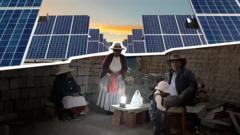Installed in 1979 during a push for energy independence, Jimmy Carter's solar panels faced removal in 1986 but embarked on a journey that would see them utilized in institutions from Maine to China, symbolizing a lasting legacy in renewable energy.
The Journey of Jimmy Carter’s Solar Panels: From the White House to Worldwide Impact

The Journey of Jimmy Carter’s Solar Panels: From the White House to Worldwide Impact
After their removal under President Reagan, the solar panels installed by Jimmy Carter continue to generate energy across the globe, highlighting the former president's forward-thinking environmental policies.
In 1979, President Jimmy Carter boldly took a step toward energy independence by installing 32 solar panels on the White House roof. This innovative move came at a time when America was grappling with the repercussions of the 1973 oil embargo, which severely impacted the economy and forced the nation to reconsider its energy policies. “No one can ever embargo the sun or interrupt its delivery to us,” Carter expressed during a launch event for the solar array, emphasizing the importance of harnessing renewable resources.
However, by 1986, the climate around renewable energy had shifted when the Reagan administration removed the panels during renovations to the roof. Contrary to their intended permanence, they vanished from the national spotlight. Yet, their story did not end there. Disposed of at a low cost, the solar panels found their way to various locations, beginning with a small college in Maine, where they continued providing power for several years before spreading to diverse sites across the United States and even reaching China.
Despite the political shift away from renewable energy in the ensuing years, Carter's initial vision and implementation of solar technology illustrated his pioneering stance on climate issues, one that many believe was well ahead of his time. The journey of these panels reflects not just a moment in history but an ongoing commitment to sustainable energy practices, resonating with current discussions about climate change and energy independence.
Notably, the first congressional hearing on climate change didn't occur until a decade later, further underscoring the prescience of Carter's environmental policies. As former Energy Secretary Ernest Moniz noted, “There’s no doubt Jimmy Carter was well ahead of his time.” The solar panels may have left the White House, but their legacy continues to inspire many in the fight for renewable energy and environmental awareness today.





















